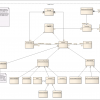 |
The Eroding Agile Test Pyramid The test pyramid is a great model for designing your test portfolio. However, the bottom tends to fall out when you shift from progression testing to regression testing. The tests start failing, eroding the number of working unit tests at the base of your pyramid. If you don't have the development resources required for continuous unit test maintenance, there are still things you can do.
|
|
 |
5 Key Factors to Achieve Agile Testing in DevOps Part of the path to DevOps requires adoption of agile methodologies. What does it mean for testing when you switch from the traditional waterfall model, with a few long release cycles per year, to the agile model, with changes occurring every two weeks? Here are five key factors to achieve the agile software testing necessary in DevOps.
|
|
 |
3 Methods for Better Communication and More Effective Testing Successful delivery of software requires the entire team, so it’s imperative that everyone choose their words carefully so they convey what they really mean, are sensitive to others’ feelings, and consider all aspects of a problem. Here are three questions to remember when communicating about your software testing projects to ensure you’re considering the power of words.
|
|
 |
Why You Need Continuous Testing in DevOps DevOps is more than adopting the right set of tools; it's a cultural shift that incorporates testing at each stage of the agile project lifecycle. Continuous testing is key to unlocking this culture change because it weaves testing activities into every part of the software design, development, and deployment processes, which helps everyone involved communicate more, collaborate better, and innovate faster.
|
|
 |
Examining Cross-functionality Bias on Software Development Teams Cross-functionality means having all the necessary people and skills on one self-organizing team. Unfortunately, the execution of cross-functionality is often biased. The main traps we fall into are misunderstanding the value of specialization, hero worship, and not “walking the cross-functional talk” as organizations. Let’s examine each of these pitfalls in the hope that your teams may avoid them.
|
|
 |
Agile Trends to Watch in 2018 With 2018 well underway, it seems like a good time to look ahead and think about what we hope to accomplish this year. Find out which agile trends these software experts are most looking forward to in the coming months.
|
|
 |
Requirements Mapping Using Business Function Test Suites On this team, testers were overcommitted, avoidable defects were surfacing, and documentation was hard to find. Worse, trust and morale were low. Upgrading tools was out of the question, so the testers decided to take matters into their own hands and create incremental change themselves. Here's how a team added a new type of traceability to its requirement test case world.
|
|
 |
The Value of Test-Driven Development when Writing Changeable Code Writing changeable code makes it easier and more cost-effective to add features to existing software. Writing changeable code doesn’t take longer, but it does require paying attention to certain things when building a system. It's important to have a good suite of unit tests that support refactoring code when needed, and test-driven development helps you create independently testable code.
|
|
 |
DevSecOps: Incorporate Security into DevOps to Reduce Software Risk DevSecOps is a growing movement to incorporate security into DevOps practices in order to ensure flaws and weaknesses are exposed early on through monitoring, assessment, and analysis, so remediation can be implemented far earlier than traditional efforts. By failing fast with security testing, organizations reduce risk of a security incident and decrease the cost of rework.
|
|
 |
4 Strategies for a Structured QA Process Being a software tester is no longer just about finding bugs. It is about continuous improvement, defining a clear test strategy, and going that extra mile to improve quality. Following a consistent, structured approach to QA will help you acquire more knowledge about the product you are testing, ask questions you otherwise may not have thought of, and become a true owner of quality.
|
|

